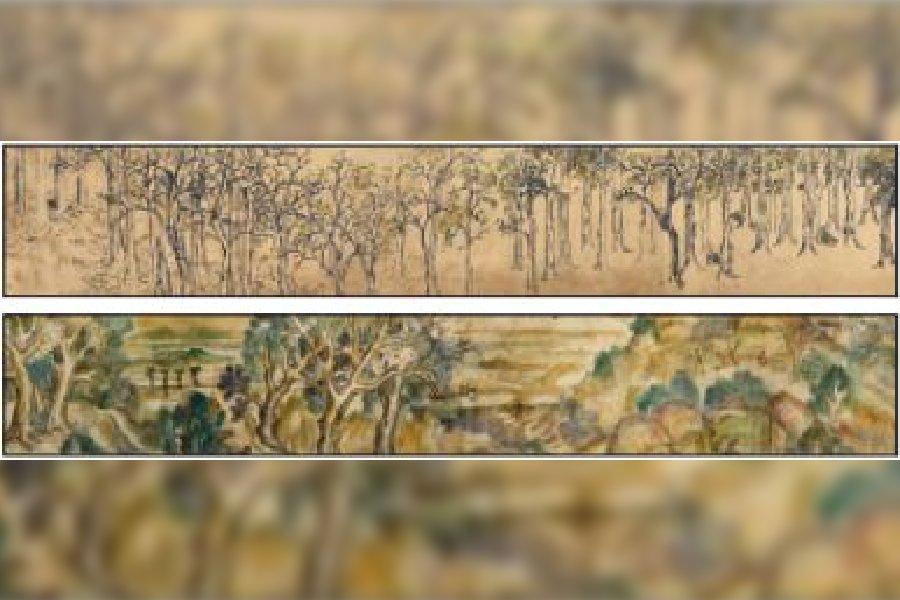A newly discovered handscroll painting by Benodebehari Mukherjee will be on show at Kolkata Centre for Creativity from May 20 as part of a month-long exhibition titled Scenes from Santiniketan: Benodebehari’s handscrolls.
The exhibition, curated by R. Siva Kumar of Kala Bhavana, Visva-Bharati, and devoted entirely to the artist’s handscrolls, will revolve around this newly discovered work.
The earliest and longest scroll, titled Scenes from Santiniketan, is 44.6ft long and was painted by Mukherjee in 1924. It was discovered recently and bought by Gallery Rasa.
“Nobody knew about this scroll. The discovery of a previously unknown work by a major artist is exciting as it helps us better understand his career. The exhibition revolves around this new discovery that depicts various aspects of the early Santiniketan landscape,” said R. Siva Kumar.
Handscrolls are long horizontal paintings that were popular in China and Japan. Chinese and Japanese art was coming to India from the early 20th century.
“The landscape handscroll is an east Asian innovation. While ancient Indian artists were keen observers of nature, landscape as a distinct genre was unknown in India before itinerant European artists brought it to India during the colonial period,” said Kumar.
“While European landscapes presented appealing views as a framed scene, east Asian landscape handscrolls allowed showing a place in its totality. Modern Indian artists became familiar with east Asian handscrolls and landscape tradition through early 20th-century Pan-Asianism. But none used it as imaginatively as Benodebehari.” Mukherjee’s teacher at Kala Bhavana, Nandalal Bose, used elements of the handscroll painting in his murals, Kumar said.
A huge part of Mukherjee’s works was on nature and landscape. No other artist has devoted himself to painting nature as he had, said Kumar.
Till 1942, Mukherjee did landscape paintings, studying in detail the Santiniketan-scape in its various aspects. “The longest scroll has these different aspects of the Santiniketan landscape,” Kumar said.
After finishing the Scenes from Santiniketan, Mukherjee gave it to his friend Sudhir Khastagir, who was a couple of years junior to him at Kala Bhavana. Much later, Gallery Rasa bought the scroll from a collector, said Rakesh Sahni of the gallery. “He didn’t have much money at the time and gave away his works for whatever was offered,” said the curator. Two full handscrolls of Mukherjee are in Kala Bhavana’s collection. Another full scroll is with the Victoria and Albert Museum in London. There are also fragments of scrolls or small scrolls by the painter.
Apart from Scenes from Santiniketan, which will be displayed in original, digital reproductions of three full scrolls (two from Kala Bhavana and one from V&A), five fragments of scrolls, three self-portraits, two pages from his Chinese sketchbook and a back-lit digital reproduction of Mukherjee’s ceiling mural for Kala Bhavana will be part of the exhibition. Earlier, two of his handscroll paintings were shown as part of a retrospective exhibition on him at the National Gallery of Modern Art, New Delhi, in 2002.
Mukherjee had shown three of his scrolls in an exhibition in 1944, along with Ramkinkar Baij, said Kumar.






